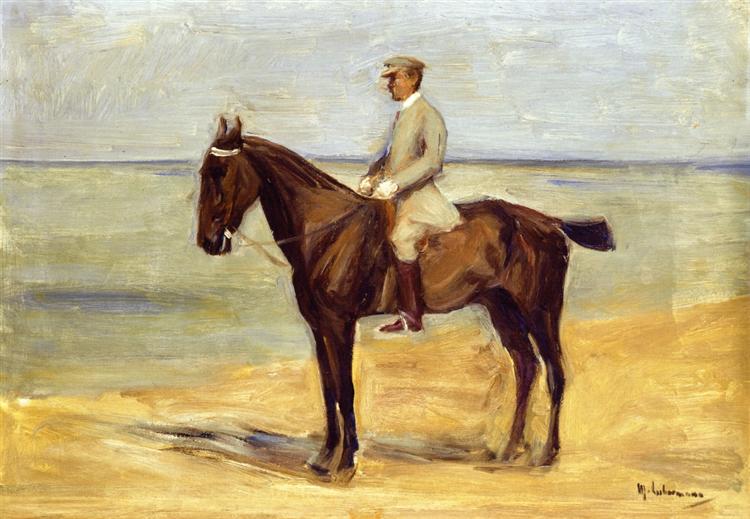Descriere
Max Liebermann's painting "Rider on the Beach Facing Left", created in 1911, is a work that captures the essence of the Impressionist movement while amalgamating the idiosyncratic atmosphere of coastal life. One of the precursors of Impressionism in Germany, Liebermann is distinguished by his focus on light and color, as well as his ability to convey emotion through nature. This piece, in particular, exemplifies his achievements in depicting the human figure in a natural setting.
In the work, a rider can be seen riding a horse on the beach, his gaze directed to the left. The figure of the rider, with his upright and elegant posture, is a representation that evokes a feeling of tranquility and contemplation. His attire, although on a minimal scale, is subtly outlined; his presence merges with the landscape, but does not dissolve into it. This aspect is fundamental to Liebermann's work, who makes the human figure a vital component of his visual narrative.
The seabed, whose immensity can be seen in the back of the composition, reflects the open skies and an atmosphere of calm. The color palette chosen by Liebermann is a dance of earthy tones and deep blues, with white accents that simulate sunlight filtering over the undulations of the sea and sand. This selection of colors not only brings the scene to life, but also allows light to play a leading role, another of the hallmarks of his style. The texture of the painting evokes the movement of water and the sea breeze, creating a sensory experience that transcends the mere image.
A fascinating element of this work is its context. Liebermann painted such scenes on several occasions, particularly on the coast of Noordwijk, where the fresh air and light of the sea provided him with constant inspiration. This period of his work is characterised by a focus on everyday life, a contrast to the more serious themes of his earlier work. In this painting, the landscape is not a mere background, but a co-actor that contributes to the visual narrative. The composition seems to invite the viewer to immerse himself in this moment of peace, to imagine the sound of the sea and the feel of the wind.
Liebermann's style is representative of a crucial moment in art history, where the transition to modernism began to leave its mark on the academic tradition. His exploration of light and color, as well as his inclusion of figures in the natural environment, anticipates the evolutions that would eventually and radically change the course of art in the 20th century. Works such as "Rider on the Beach Facing Left" bear witness to his mastery in capturing the essence of a specific moment, in which the timelessness of the landscape and the fleeting nature of the human instant are intertwined.
"The presence of the rider is symbolic, suggesting not only the act of observing, but a reflective experience about man's relationship with nature. Liebermann offers us a visual gift that invites us to contemplate not only the beauty of the scene, but also the autonomy of the viewer in interpreting that evocative moment." In this sense, "Rider on the Beach Facing Left" becomes a work that transcends its time, promoting a dialogue between the observer and the world surrounding the figure of the rider.
KUADROS ©, a famous painting on your wall.
Hand-made oil painting reproductions, with the quality of professional artists and the distinctive seal of KUADROS ©.
Painting reproduction service with satisfaction guarantee. If you are not completely satisfied with the replica of your painting, we will refund 100% of your money.

